To access all site contents, click HERE.
Why do we run this separate item, Mike Royko 50 Years Ago Today? Because Steve Bertolucci, the hero of the serialized novel central to this Substack, “Roseland, Chicago: 1972,” lived in a Daily News household. The Bertoluccis subscribed to the Daily News, and back then everybody read the paper, even kids. And if you read the Daily News, you read Mike Royko. Get your Royko fix on Twitter too: @RoselandChi1972.
Mike just got back from a five-week family vacation in Europe! See last week for the first Europe columns, and a look at the family’s voyage over on the S.S. France in the Weekend Edition via David Royko. This week, Mike finishes up his travelogue.
The Daily News runs a promo on the front page every day for Mike’s column, so I’ve included those too.
Note: Three of today’s four columns are reprinted in full in “Slats Grobnik and Some Other Friends”—so go get it! The September 13 column isn’t in any collections.
Where did Mike set pins? It’s in the Chicago History Rabbit Hole coming up under September 12.
September 11, 1972
Mike’s in Oberammergau, Germany—ostensibly because he’s been told it’s a great place “to escape from the worries of the world.” There is nothing to do, except every ten years when the village puts on a Passion Play. The play isn’t due until 1980.
So Mike eats some schnitzel and he’s ready to turn in when:
“I heard a sound I have learned to hate—the rumble of motorcycles.
“Actually I don’t hate all motorcycles. Only those that rumble outside my window at night. I don’t mind when they go roaring down a highway at breakneck speeds, because I know there is a chance they will break their necks.”
A bunch of long-haired young men show up on the motorcycles, park in front of Mike’s hotel and proceed to laugh and talk loudly. Soon some elderly men wearing “the traditional Alpine short pants and walking shoes”—come out of their cute little gingerbread-like houses to yell at the youngsters.
It’s a stand-off, until the old men disappear and return with a dog— “as big and mean a German shepherd as I have ever see outside a Chicago tavern.”
This gets the young men’s attention. There is much yelling and barking. A man in a shirt and tie arrives and tries to reason with both sides, then complete chaos breaks out when a siren sounds in the distance.
“German official vehicles have the most hair-raising sirens,” Mike observes. “Maybe I saw too many 1940s movies, but when I hear that remorseless sound, I get the urge to flee to a hidden room in the cellar.”
The young men feel the same way. Motorcycles are flying everywhere as they start and mistart in their haste to escape the police, all as “the terrifying sound of the siren was getting closer and louder.”
But it was just an ambulance, which passed by.
“I decided I liked Oberammergua,” Mike concludes. “It’s a place where a Chicagoan won’t feel homesick.”
September 12, 1972
“MONTE CARLO—The first time I ever gambled, I knew I was a born high roller,” Mike opens. “We pitched pennies in the schoolyard, and I threw my penny so high it rolled into a sewer.”
“This led to shooting dice with other pinsetters in the back of the old Congress Bowling Alley on Milwaukee Av. A sly, old wino taught us the rules. He also taught us never to shoot dice with a sly, old wino.”
We’ll come back to the Congress Bowling Ally.
Mike would go on to all sorts of gambling forms, but he particularly fell under the spell of James Bond and his adventures in “Casino Royale,” the original book version. There, a steely James Bond beats evil villain Le Chiffre in a game of baccarat when Bond coolly says, “Banco”—which means you’re betting your opponent’s entire bank roll.
Mike has tried for years to duplicate that kind of Casino Royale experience, with no luck. When he went to Vegas, he didn’t even bet after getting a look at all the golf shirts and pot bellies. This European trip hasn’t been any better so far, so Mike eventually drives to Monte Carlo for its famous casino.
Like James Bond, Mike pauses before the mirror on the way out of his hotel room. “My eyes blinked back through horn-rimmed glasses. The lightbulb reflected on my receding hairline. A thin scar on the bridge of my nose gave it a pronounced lump.”
He places his Dr. Scholl’s arch supports in his shoes and strikes out for the casino, “a huge, baroque building, surrounded by gardens, bathed in flood lights.”
However, inside: “It looked like the kind of place where a couple of crazy old ladies would live with 100 cats and stacks of old newspapers. The furnishings were something from a Goodwill store. The chandeliers had as much glitter as a Pixley & Ehlers coffee cup.”
It was a dump. On the way out, Mike asked the doorman if he knew Mr. Le Chiffre. He did not.
“‘Well, if he shows up,’ I said, ‘tell him I’ll meet him outside. We can pitch some pennies.’”
Here’s that rabbit hole I promised.
The Congress Bowling Alley
Let’s remember that Mike grew up in an apartment above his family’s tavern, The Blue Sky Lounge, at 2122 N. Milwaukee. Today, it is a dentist office.

The Congress Theater is almost directly across the street from the former Blue Sky Lounge. As readers in 2022 will know, the Congress Theater is in awful shape in that year. The whole block looks awful, although the residential streets nearby are only slightly scruffy in spots, IMO.
Naturally I wondered if the Congress Theater had something to do with the Congress Bowling Alley, where Mike pitched pennies allegedly with an old wino, and set pins before the age of mechanical bowling alleys.
Yes and no.
Per John D. Cramer on Wordpress, the Congress Bowling Alley stood at 2047 N. Milwaukee, just a block south of Mike’s family’s tavern—in the same block as the Village Discount location with which 2022 readers may be familiar, just north of the Milwaukee/Armitage intersection. Also just a block north of Margie’s on Milwaukee.

In his terrific post “‘A Recreational Masterpiece’ on Chicago’s Milwaukee Avenue,” architect John D. Cramer runs down the history of the building, erected in 1925 at the same time as the Congress Theater. The unknown creators of the Congress Arcade, writes Cramer, were clearly competing with the regal Congress Theater. The Arcade’s terra cotta, he writes, was almost identical.
It was a time when “multi-story urban bowling and billiard halls” were popular, and of all its competitors, the Congress Arcade rightfully called itself “A Recreational Masterpiece.”
Cramer uses the picture from Dr. Jake’s Bowling History blog to give a taste of the Congress Arcade’s original glory, which is still somewhat evident below in 1975 in its incarnation as the Mill Bowl:

Who would recognize it today, with its top floor shaved off? But at least it’s still there.
For the ‘20s and ‘30s, the Arcade made the papers regularly for its boxing matches.
But bowling superseded boxing in the ‘40s, becoming a massive city sport. Nearly every company and club had a bowling team, leagues were legion, and newspapers ran columns devoted to the city’s bowlers, their tournaments and standings. So the Arcade stopped advertising fights, and started focusing on the bowling.
Here’s one clip in which the Sakowitcz Tavern team was set to play the Gold Coat Gills at the Congress Arcade.
I trust many older readers will recognize the name “Sakowitcz.” The Meister Braus, by the way, were always a very successful city bowling team.
The Tribune ran “The Chicago Tribune Free Bowling school” at various spots, including the Arcade. Here’s a clip from 1942. You’ll want to read it just for the name of an assistant instructor.
The Congress Arcade’s last mention in the Tribune is in 1966, and at some point it turned into the Mill Bowl.
There was another little Chicago history nugget in this column:
Pixley & Ehlers
“The chandeliers had as much glitter as a Pixley & Ehlers coffee cup,” Mike scoffed about the drab Monte Carlo casino.
Poor Pixley & Ehlers, a respectable if pedestrian chain of up to 15 diners in Chicago. This 1937 mug from the Restaurant Wares Collectors Network is actually quite interesting:
According to the Restaurant Wares Collectors Network: “John Albert Pixley, born March 9, 1879 in Portage, Wisconsin, founded the Pixley and Ehlers chain of restaurants and was president of the company from 1899 to 1954. By 1945, the chain had expanded to include 15 outlets across Chicago and was out of business in Chicago by 1975. There were at least 13 locations, known as lunchrooms, in New York City.”
Per the Tribune’s 1949 account of Pixley & Ehlers 50th anniversary, it was “Albert J. Pixley” who founded the chain in 1899, with the first location at 155 W. Madison. On February 23, 1949, the chain gave free cake to every customer at its then 14 restaurants, “even those who just bought coffee”:
“Formal observance of the anniversary was at 3 p.m., when an 800 pound cake was placed in the window of the restaurant at 80 E. Randolph st. and was cut by Miss Carmen Guterez, dancing star of ‘Finian’s Rainbow.’”
That restaurant was in the building that preceded the current high-rise at the northwest corner of Randolph and Michigan. We know from an article farther down that the Pixley & Ehlers had windows on Michigan Avenue too.
Pixley & Ehlers listings in the Tribune archive begin in 1924, when the company subleased a basement at 20-22 S. Clark for a new restaurant to join the several other Loop locations already up and running. Later that year, Pixley & Ehlers committed to build a $1,500,000 eight-story fireproof “bachelor’s hotel” at 180 N. Wells—now a parking garage. The Trib says “the loop luncher will associate” the name “Pixley & Ehlers” with “beans and other high speed provender”. The new hotel was to include “an elaborate lunchroom occupying all of the first floor.” All but two of the locations were in the Loop.
Here’s the first Pixley & Ehlers display ad in the Trib, from 1925.
And from 1929:
By 1936, the number of Pixley & Ehlers stood at 13—and they had just finished air conditioning all of them. The chain continued expanding until the World War II. In 1944, Tribune sketch artist Gary Sheahan visited the troops in the Pacific and drew this picture of Pvt. Edward Blesiada, a paratrooper who was a truck driver for Pixley & Ehlers before the war.
Naturally we can count on John Chuckman’s Photos on Wordpress for some visuals. Here’s a postcard circa 1950, unknown street, with a Pixley & Ehlers sign in the lower left. Available Pixley & Ehlers pictures are never actually of Pixley & Ehlers, so you’re lucky to just get a look at the sign.
UPDATE: Reader Garry writes, “The Pixley & Ehlers at the ‘unknown location’ is obviously Chicago & Clark, as that's a 22 Clark Green Hornet streetcar, just out side the Cosmopolitan Bank on the NE corner, so the Pixley restaurant was on the NW corner of Chicago & Clark.”
Well of course. I felt I knew that bankish building in the foreground right, but couldn’t quite place it, and I see why now—the facade underwent some changes when it was renovated some years prior to 2022. Plus, it looks like the part of the bank just past the big archway was taken off to serve for part of the site of the current high-rise next door—see below. And in the 1950s picture above, with nothing tall enough in the way, that’s the Newberry Library in the distance up Clark!
The shot above is the closest Google Streetview would let me get to duplicating the angle from the 1950s postcard. Below, a better look at the building at the northwest corner, which housed the Pixley & Ehlers at its corner. I think the building has a name, and if I recall correctly it narrowly escaped demolition not so long ago. Perhaps another knowledgeable reader will remind me of those answers.
And of course John Chuckman also provides us with a matchbook…
…and a menu.
The Trolly Dodger, whose real interest is streetcars of course, happens to include a Pixley & Ehlers sign in this photo of the intersection of North Avenue and Clark:
You can just make out the Pixley & Ehlers sign in the lower righthand corner. Today, as the Trolley Dodger notes, the Plaza Hotel is the Latin School, and the building housing the Pixley & Ehlers is a bank.
Norbert Blei wrote a long 1969 Trib article on 10 bargain restaurants not to miss, and his first pick was the Pixley and Ehlers “across from the library” at 80 E. Randolph.
“Because of the people, you have to begin with breakfast at Pixley & Ehlers across from the library,” wrote Blei. “You don’t see many Pixley people in TV commercials, magazine ads or even suburbia for that matter. But they keep walking by the window at Pixley’s and getting caught in that revolving door.
“Everybody from madmen to saints eat at Pixley’s. The boys from the sanitation department are usually at hand. Throw in a shoemaker, some train conductors, the ‘girls’ from the dress shows, a perplexed upper Michigan Avenue mother and child, and all the lost men and women who look like they need work but have learned how to survive.”
Blei describes a rather chaotic cafeteria line for the food, and recommends the Early Bird special: “one egg, one bacon strip, toast, jelly, coffee, is 60 cents [$4.84 in 2022] worth of good, hot breakfast. Better yet, 32 cents [$2.58] will buy the best chocolate doughnut and coffee in town.”
“And, whatever you buy, you’re entitled to any open seat at the window—east side preferred, more window to look out of. Sitting at the sunny window, eating breakfast at Pixley’s, watching the world outside or listening to it on the inside, is a simple pleasure unequaled in Chicago. All for 32 cents or less—a second cup of coffee is free.”
Since the Trib lists six Pixley & Ehlers restaurant open all night for Halloween in 1970, we know the Pixley & Ehlers location at that time also included 153 E. Ohio, 18 E. Van Buren, 502 W. Jackson, 6 S. Clark and 18 N. Wells. They were all gone by 1974.
Older Readers, does anyone have memories have Pixley & Ehlers to share? Send in comments, please, or email RoselandChicago1972@Substack.com!
If you dig Mike Royko, you’ll want to see the news he’s writing about. Check it out here!
September 13, 1972
Mike didn’t give up on finding a nice casino. He ends up in Baden-Baden, Germany, in the Black Forest. He says his purpose was to get a cuckoo clock.
“Every columnist should own one because they provide an honest, hourly critique.”
And by sheer luck, Mike finds the kind of casino he’s been dreaming of, the kind of casino where James Bond might say “Banco” to Le Chiffre. He opens with a description of his opponent:
“He sat directly across the card table from me, a heavy scowling man in a white dinner jacket, with a big pile of chips in front of him,” Mike writes.
“At his side was a small table, upon which rested an open bottle of champagne in an ice bucket, and two glasses.
“Seated to his side, and slightly behind him, was an attractive blond in a long black gown, at least 20 years younger than he.
“He was too good to be true, with his diamond ring and thin, black cigar.”
Mike has gone to great lengths to prepare for the evening, emulating Bond in “Casino Royale” by ordering caviar and cold vodka in his hotel room first, then taking two Maalox because “Bond had a stomach like a goat.”
But eventually he gets to the casino, he gets to the baccarat table, and he’s sitting with this guy who could be Le Chiffre. He’s all set to say “Banco,” which means betting the dealer’s entire stack, but when he finally does the math in his head to figure out how much money is involved in American dollars, he realizes it’s $1,150—which would be $7,762.50 in 2022.
“Did you say ‘Banco’?” the croupier asks him, not sure how to interpret Mike’s strangled noises.
“I looked at the dealer’s chips. ‘For that?’ I laughed. ‘It’s not worth the effort. I’ll be back when there’s some real action.’
“With a slight yawn I rose and strolled from the table. And the room. And the casino.
“James Bond. Big deal. What the hell did he care? He didn’t have kids to send through college.”
September 14, 1972
Now Mike understand how his relatives felt fleeing the old country. He made the mistake of renting a car to drive in London.
“Two minutes after I pulled out of the London rental agency to drive to my hotel and get my luggage, I was lost. And I was squeezing the steering wheel.
“I don’t care what you have heard about the drivers of Rome or Paris, or how many times you have made it through the Edens-Kennedy whirlpool, or survived the Dan Ryan on a Saturday night. They are Sunday morning drives compared with London.
“Left-side driving is part of it. It’s much harder to adjust to than you might think.
“But the real terror comes from the London streets and the English driver.
“London wasn’t laid out for cars. I don’t think it was laid out for the horse and carriage. The narrow winding streets—none of which appears to be more than three blocks long—were designed for Jack the Ripper to prowl in fogs.”
Soon, Mike feels like a 70-year-old farmer from Wisconsin in Manhattan. A crazy English driver nearly hits him head on, and Mike sideswipes some parked cars. Then he can’t find anyone to talk to about it, so he drives away, gets lost, and realizes he can’t even report it to the police anymore. He’s sure a little old English lady named Maude saw the whole thing and reported him to the police.
Mike boards his ship for home the next day expecting to get arrested at any moment. He locks himself in his cabin until the ship is safely at sea.
“Then I went on deck, looked in the direction of England, and thumbed my nose at Maude.”
September 15, 1972
As we here all know, weekends could be sad for a Daily News family because Mike Royko wasn’t in the Daily News’ single weekend edition. So we look for Mike elsewhere on weekends.
Thanks to Bob Herguth, we get a look at Mike’s 1972 softball season.
September 13, 1972
By the way, this feature is no substitute for reading Mike’s full columns. He’s best appreciated in the clear, concise, unbroken original version. Our purpose here is to give you some good quotes from the original columns, plus the historic and pop culture context that Mike’s original readers brought to his work. Sometimes you can’t get the inside jokes if you don’t know the references. Plus, many iconic columns didn’t make it into the collections, so unless you dive into microfilm, there’s riveting work covered here you will never read elsewhere.
If you don’t own any of Mike’s books, maybe start with “One More Time,” a selection covering Mike’s entire career which includes a foreword by Studs Terkel and commentaries by Lois Wille.
Do you dig spending some time in 1972? If you came to MIKE ROYKO 50 YEARS AGO TODAY from social media, you may not know it’s part of the book being serialized here: “Roseland, Chicago: 1972.” It’s the story of Steve Bertolucci, 10-year-old Roselander in 1972, and what becomes of him. Check it out here.
To get MIKE ROYKO 50 YEARS AGO TODAY in your mailbox weekly along with THIS CRAZY DAY IN 1972 and new chapters of the book—
SUBSCRIBE FOR FREE!





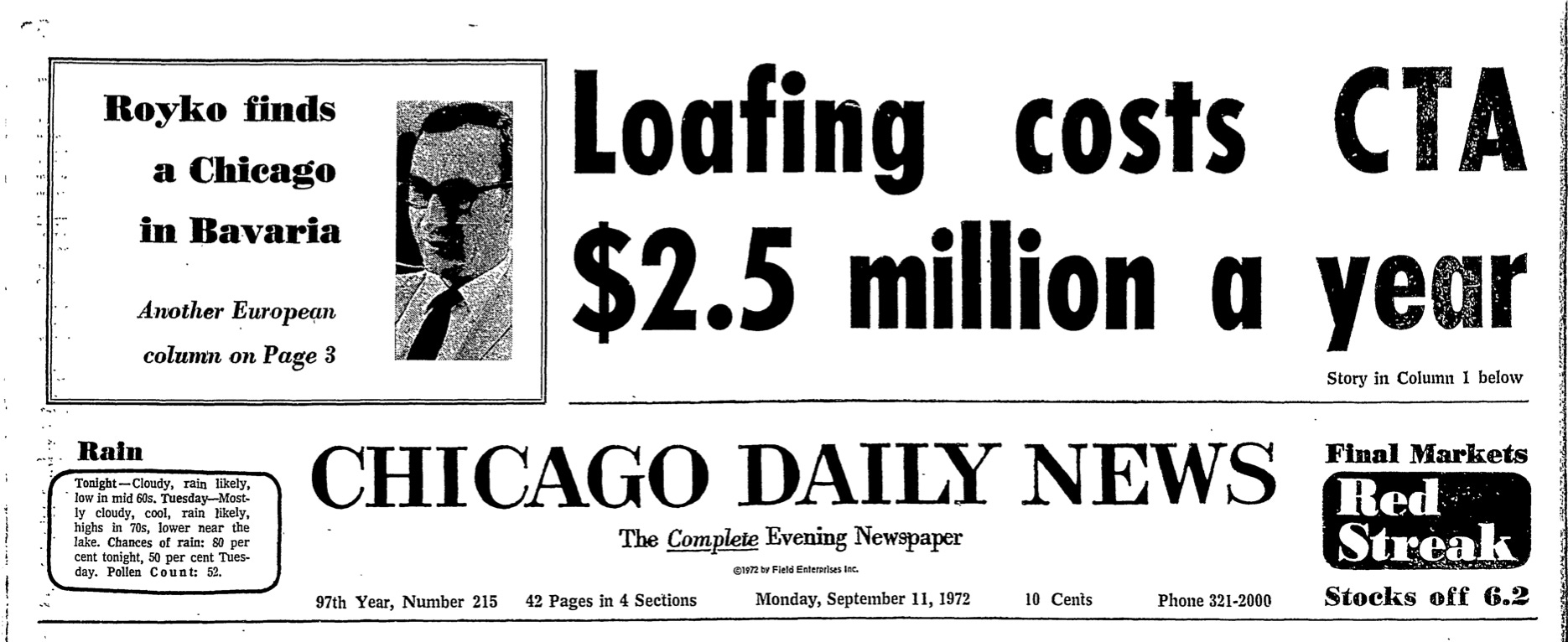
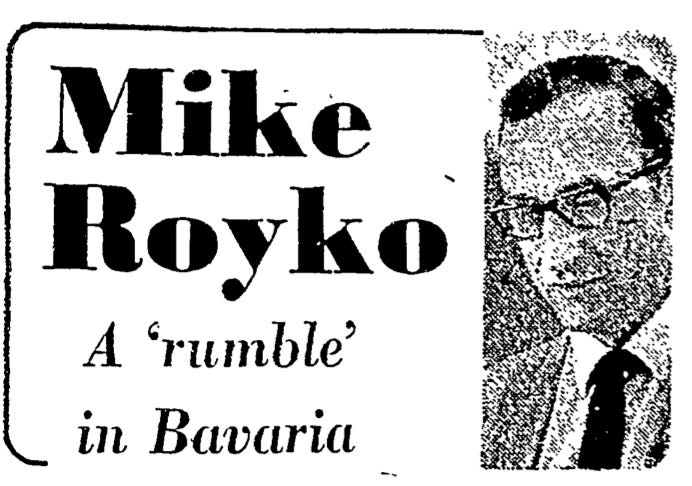









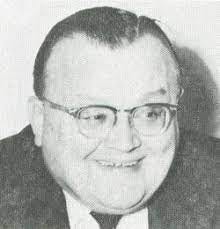
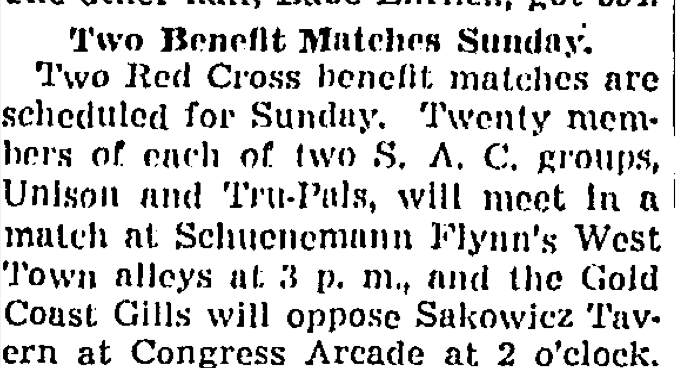


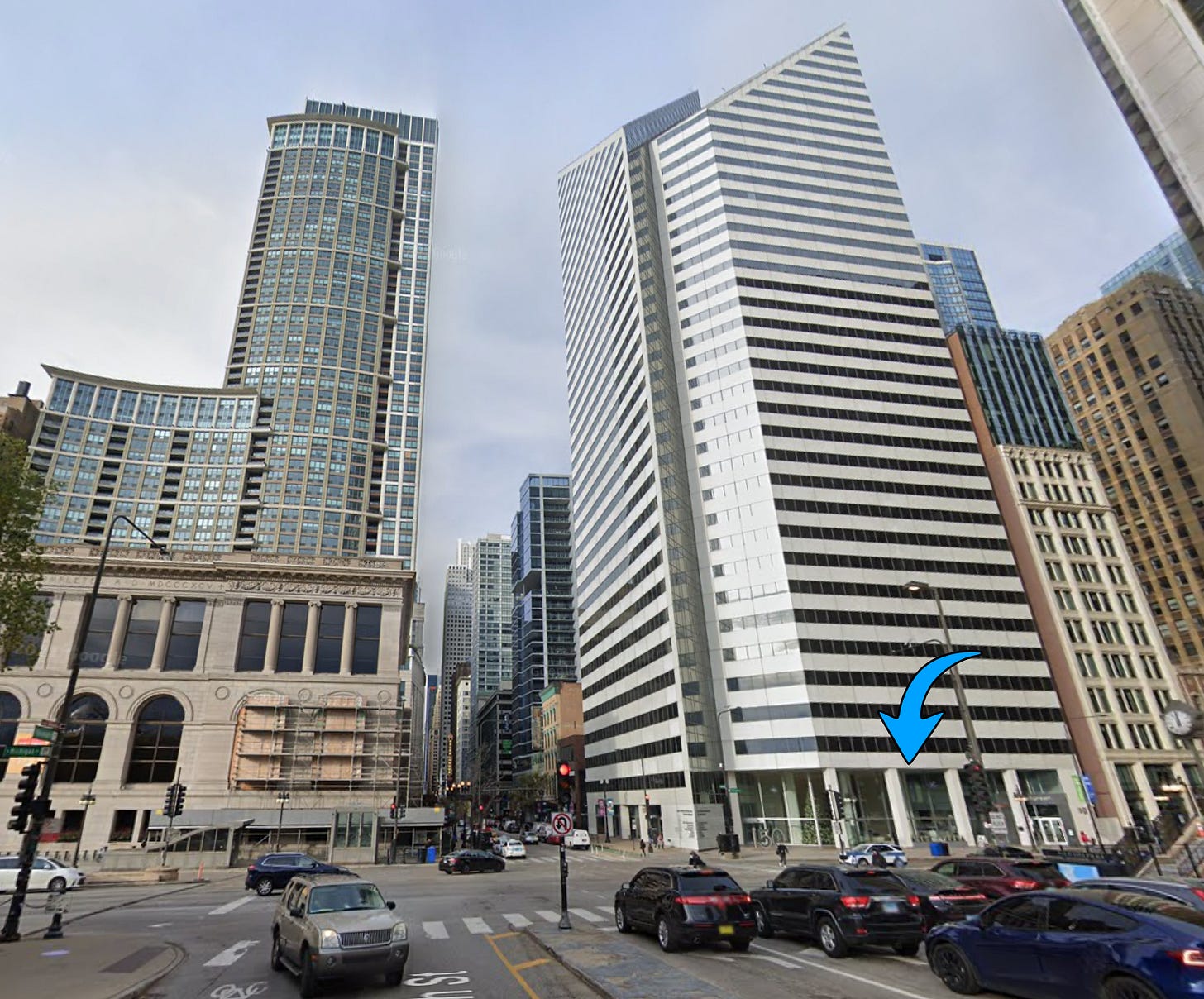



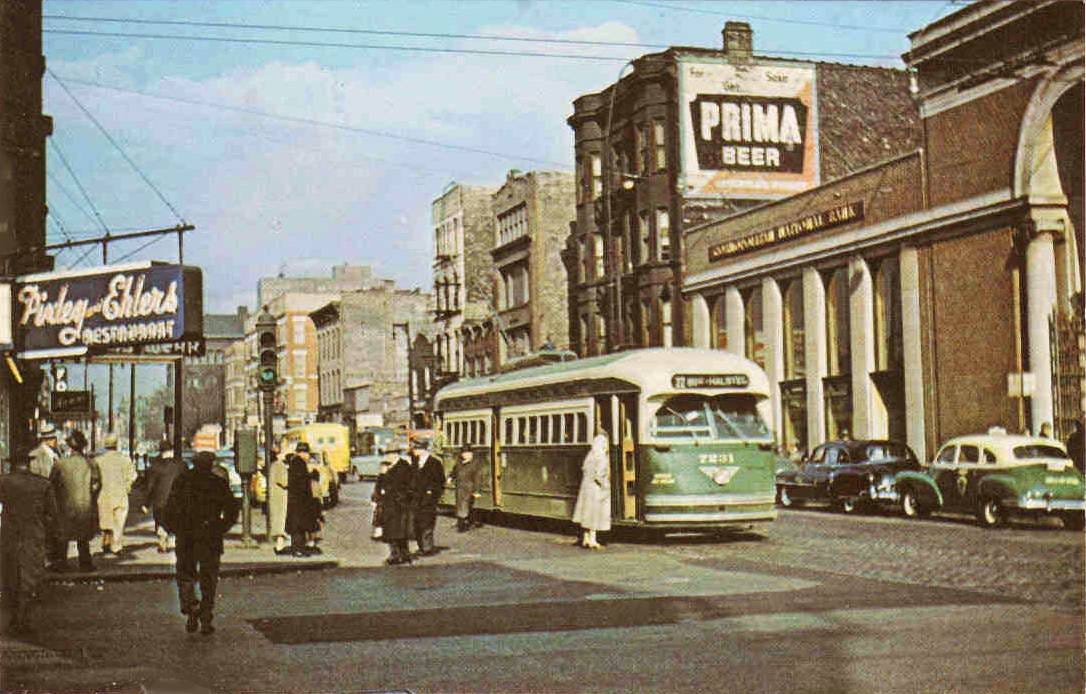












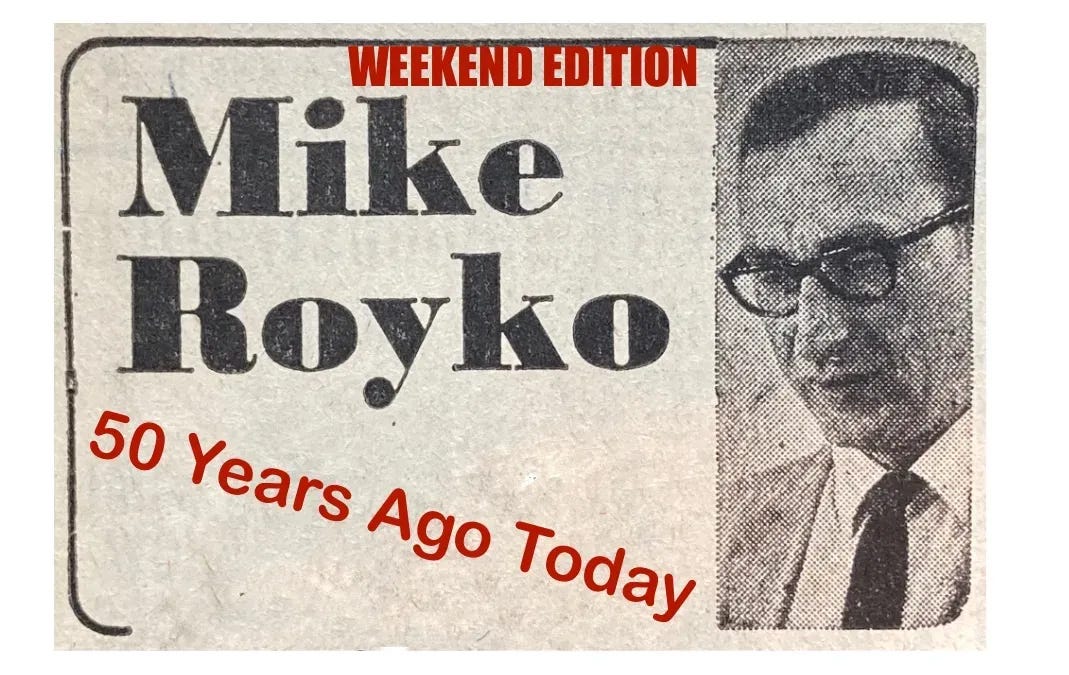



1. That Oberammergau passion play was still virulently anti-Semitic in 1980.
2. The Pixley & Ehlers at the "unknown location" is obviously Chicago & Clark, as that's a 22 Clark Green Hornet streetcar, just out side the Cosmopolitan Bank on the NE corner, so the Pixley restaurant was on the NW corner of Chicago & Clark.